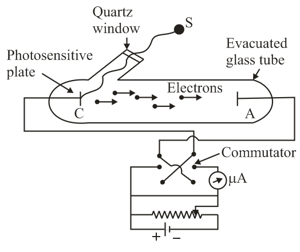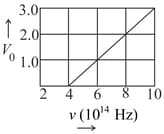EASY
Earn 100
Stopping potential in the experimental setup shown in the figure is


(a)positive potential given to the plate A for which the photocurrent stops or becomes zero
(b)positive potential given to the plate A for which the photocurrent stops increasing
(c)negative potential given to the plate A for which the photocurrent stops or becomes zero
(d)positive potential given to the plate A for which the photocurrent saturates
50% studentsanswered this correctly
Important Questions on Photoelectric Emission and Production and Properties of X-rays
HARD
In a historical experiment to determine Planck's constant, a metal surface was irradiated with light of different wavelengths. The emitted photoelectron energies were measured by applying a stopping potential. The relevant data for the wavelength of incident light and the corresponding stopping potential are given below:
| 0.3 | 2.0 |
| 0.4 | 1.0 |
| 0.5 | 0.4 |
Given that Planck's constant (in units of ) found from such an experiment is :
HARD
A metal plate of area is illuminated by a radiation of intensity . The work function of the metal is The energy of the incident photons is and only of it produces photo electrons. The number of emitted photo electron per second and their maximum energy, respectively, will be:
MEDIUM
The maximum velocity of the photoelectrons emitted from the surface is when light of frequency falls on a metal surface. If the incident frequency is increased to , the maximum velocity of the ejected photoelectrons will be:
MEDIUM
When a metallic surface is illuminated with radiation of wavelength , the stopping potential is . If the same surface is illuminated with radiation of wavelength , the stopping potential is . The threshold wavelength for the metallic surface is:
HARD
The radiation corresponding to transition of hydrogen atom falls on a metal surface to produce photoelectrons. These electrons are made to enter a magnetic field of . If the radius of the largest circular path followed by these electrons is 10.0 mm, the work function of the metal is close to :
MEDIUM
Radiation of wavelength is incident on a photocell. The fastest emitted photoelectron has a speed . If the wavelength is changed to , the speed of the fastest emitted photoelectron will be
MEDIUM
On a photosensitive material, when the frequency of incident radiation is increased by , the kinetic energy of emitted photoelectrons increases from to . The work function of the surface is
MEDIUM
A photoelectric material having work-function is illuminated with a light of wavelength . The fastest photoelectron has a de Broglie wavelength . A change in wavelength of the incident light by results in a change in . The ratio is proportional to
HARD
The magnetic field associated with a light wave is given, at the origin, by If this light falls on a silver plate having a work function of what will be the maximum kinetic energy of the photoelectrons?
MEDIUM
When a certain metallic surface is illuminated with monochromatic light of wavelength the stopping potential for photoelectric current is and when the same surface is illuminated with light of wavelength the stopping potential is The threshold wavelength of this surface for photoelectric effect is
MEDIUM
A metal surface is illuminated by light of two different wavelengths 248 nm and 310 nm. The maximum speeds of the photoelectrons corresponding to these wavelengths are u1 and u2, respectively. If the ratio and , the work function of the metal is nearly
HARD
Light of wavelength falls on a cathode plate inside a vacuum tube as shown in the figure. The work function of the cathode surface is and the anode is a wire mesh of conducting material kept at a distance from the cathode. A potential difference is maintained between the electrodes. If the minimum de Broglie wavelength of the electrons passing through the anode is which of the following statement(s) is(are) true ?

MEDIUM
When photons of wavelength are incident on an isolated sphere, the corresponding stopping potential is found to be . When photons of wavelength are used, the corresponding stopping potential was thrice that of the above value. If light of wavelength is used then find the stopping potential for this case:
EASY
The photoelectric threshold wavelength of silver is . The velocity of the electron ejected from a silver surface by ultraviolet light of wavelength is:-
MEDIUM
A photoelectric surface is illuminated successively by monochromatic light of wavelengths If the maximum kinetic energy of the emitted photoelectrons in the second case is times that in the first case, the work function of the surface is :
MEDIUM
The stopping potential (in volt) as a function of frequency for a sodium emitter, is shown in the figure. The work function of sodium, form the data plotted in the figure, will be:
(Given: Planck’s constant , electron charge

HARD
A beam of electromagnetic radiation of intensity is comprised of wavelength, . It falls normally on a metal (work function ) of surface area of . If one in photons ejects an electron, total number of electrons ejected in is . then is ___________
MEDIUM
Photons with energy of are incident on a cathode, in a photoelectric cell. The maximum energy of emitted photoelectrons is When photons of energy are incident on , no photoelectrons will reach the anode, , if, the stopping potential of relative to is
MEDIUM
The anode voltage of a photocell is kept fixed. The wavelength of the light falling on the cathode is gradually changed. The plate current of the photocell varies as follows :
MEDIUM
Light of wavelength is incident on a metal with work function . The de Broglie wavelength of the emitted electron is:

